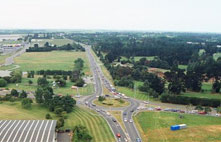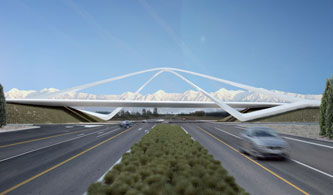Design principles
A partnership of the NZ Transport Agency, the Christchurch City Council (CCC) and Christchurch International Airport Limited (CIAL) ran an urban design competition to develop a design concept for this bridge that will enhance the significance of the Memorial Avenue and Russley Road (SH1) intersection. The brief provided to the competitors outlined a number of design principles to be incorporated into the final concept.
The principles:
- create a legacy for Christchurch
- enhance the intersection as a ‘Gateway’ to Christchurch, Canterbury and New Zealand
- respond to views of the Port Hills and the Southern Alps
- respond to the character of Memorial Avenue, heritage elements and wider Christchurch
- effective integration with surrounding land uses
- respond to tangata whenua history and values
- low-impact design
- consider value for money in terms of ‘whole of life’ cost of infrastructure.
The design competition process
Five design teams involving architects, urban designers and sculptors were invited to submit a concept that would reflect the design principles. The five design concepts were presented to a review team consisting of personnel from the NZ Transport Agency, CCC and CIAL. The review team sought expert input from an urban design panel, from iwi and also considered a review of the costs and structural engineering aspects for each option. The chosen design concept was then developed further through a detailed engineering design process, which has resulted in the gateway option presented here.
What is the concept all about?
A gateway to the south
The design draws on the vertical power of the Southern Alps and the braided rivers, unique to the Canterbury Plains. The design will provide a dramatic gateway for all travellers on Memorial Avenue and Russley Road (SH1). This is achieved by having the bridge’s structure obliquely cross SH1 in a clear arc, which is equally powerful from all points of view.
As a Christchurch legacy project, the design will generate a unique and memorable view. Linking the speed and adventure of travel with the essence of the local landscape, the project aims to capture the unique moment of arrival and departure from the city of Christchurch.
Integrated concept
The bridge is more than functional - it is symbolic of the crossing of paths and the convergence of air and land travel. The arching, fluid form captures the dynamism, excitement and speed of travel on the ground and in the air, recognising the unique airport location within the alluvial patterns of the Canterbury Plains. The finely tuned structure refers to both the manufacture and movement of aircraft.

The current intersection
The landscape
The design is a natural outcome of considering the location. The landscape itself provides the most powerful possible inspiration through the Southern Alps and the braided rivers that are unique to the Canterbury Plains. By directly translating the vertical power of the Alps and the crossing of strands of rivers, the design captures the essence of Christchurch’s geography in a clear and memorable way.
Cultural and historical references
Historically this area of Canterbury was a place people passed through on the way to Puari pā on the banks of the Ōtākaro (Avon River) to gather mahinga kai (traditional food sources) in the wetlands and waterways of Ōtautahi. The two arches symbolise the coming together of cultures.
What did the other concepts look like?
The chosen design

The Portal – Boffa Miskell, Warren and Mahoney, Holmes Consulting Group, Traffic Design Group